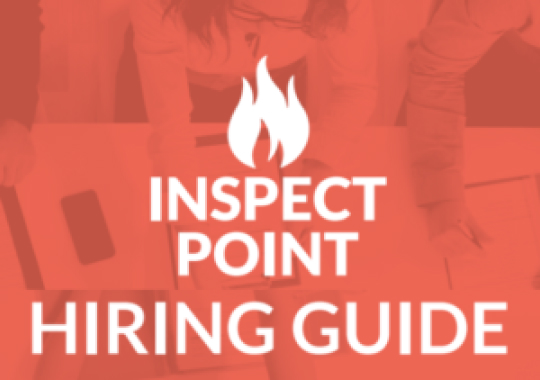
Managing an NFPA fire inspection, and protection, business can be challenging.
Along with the moving pieces that any business owner or manager must maintain, couple that with NFPA codes that are often changing, and fire inspectors who have to keep current on the knowledge, well…it’s definitely an all-hands-full type of industry.
What really sets your industry apart from most other is that the fire inspectors on your team are vital to ensuring that individuals are safe where they live, work, and play. Your clients need to know that by choosing you as their fire protection provider, they made the right choice. They want assurance that your inspectors are always on top of changes, and updates, to fire inspection codes, and that they will translate their knowledge into a thorough, well performed inspection that always places safety first.
This is why we thought long and hard about what kind of knowledge and understanding novice fire inspectors need to have when learning about NFPA codes, and when performing an inspection. We work with many different fire protection businesses – from your small fire inspection business to national chains – and we have learned a lot from fire inspectors along the way.
While there are different ways to learn, and certifications that you need (or don’t – NFPA 25 for example), we believe the four methods we touch on will give your fire inspectors a definite advantage over the competition in the long run.
And hey, who doesn’t want to be the best in the business?
The First Two Methods: Reading and Observing
Now don’t get me wrong – there can absolutely be MORE than four methods, (not even touching on certifications you might need to have based on where your inspection business is located) and if you have a method that works for your fire inspectors when they are in the thick of the learning process, please share it with us.
The conclusion we arrived at is that these four made the most sense, especially because everyone learns differently and can benefit from various types of educational styles.
However, we do strongly recommend that you take a professional NFPA training course. When you take certain NFPA training classes, they count toward your NICET certification, which is also another huge benefit of the classroom training.
At Inspect Point, we partner with some of the NFPA 25 training classes. If you would like to learn more about our partnership with them, request a demo and we can definitely talk about it.
Now, back to the educational methods…
In this blog post we’re going to talk about the first two methods – Reading and Observing. We’ve grouped these two methods together not only because they logically flow from one to the other, but also because they are both forms of visual learning.
Method One: Reading the NFPA Codes
Now you might be thinking it’s silly to list reading as one of the learning methods that can help someone to become the best at what they do, but not everyone loves to read. Also, we now live in a world where everything is FAST. Reading through (to the point of understanding) the NFPA codes, standards, recommended practices and guides is not something you can do in one night, and it’s not exactly a bodice ripper, if you know what I mean.
Taking the time to fully read through the NFPA guides might not be at the top of your fire inspector trainees’ to-do lists, but you should absolutely encourage them to put time into that type of educational activity.
Some students will want to take notes as they learn, and this is another way to ensure the information is retained. Reading is a visual learning method, and taking notes is a physical learning method. Combined both skill sets are utilized and this is a great way to let the knowledge sink in. There’s an old saying about note taking when reading: Think it and ink it. Doing both is the key to retention.

That being said, the NFPA codes and standards were developed for a reason, and the bottom line is that they are written documents that the best fire inspectors know inside and out.
The NFPA website is full of free, and paid, information that will educate both new fire inspectors, who are just starting out in their careers, as well as seasoned inspectors who need to keep up with changes to the codes.
While the sheer amount of information can seem overwhelming, by carving out some time each week to review the codes, your new fire inspectors will soon enough be able to recite them, as well as understand the greater meaning behind them.
Method Two: Observing Professional Fire Inspectors
Another visual method, but a more interactive one, is observing professional fire inspectors in the field. This is the first part of what an apprenticeship looks like, and fire inspectors in training should tag along to as many different inspection sites and with as many different fire inspectors as they can.
There might be ways that a fire inspector, with 20 years under his or her belt, does things that new inspectors pick up on more easily than someone with only a few years in the field. This might not always be the case, though. It’s important to remember that while experience is important, it does not always mean that person is an excellent trainer.
You might find the fire inspector who was thrilled to switch to the new fire inspection software is the one who can show a rookie inspector not only how to conduct a thorough inspection using NFPA 25 codes and standards, but also understands how to deliver a service proposal and close the deal then and there.

The top fire inspectors you want on your team, and training the new guys, are the ones who know what they’re doing and who also know how to close service proposals to offer exactly what an organization, or business, needs to prevent potential fires.
Send your fire inspector trainees out with the best teachers you have, and let them observe their strengths in the field. If you have a guy who’s a wonderful fire inspector known for completing inspections quickly and thoroughly, send the trainee out with him. If you have another guy who takes a little longer to complete his inspections, but he knows how to close a deal that will enable your business to be the one-stop-shop for all of your clients’ fire protection needs, send him out with that guy, too.
Your trainees should be able to take the best practices from each veteran fire inspector they observe, and start to build their skill sets this way. For example, when fire inspectors are starting to become familiar with the NFPA codes, encourage them to “think it and ink it” for better knowledge retention. They should also have an iPad to practice on when observing in the field. They can use it to test your fire inspection software and also to take notes/make observations on while observing inspections being performed.
Fire Inspection Training Questions for You
Now that we’ve given you the first and second (of four) fire inspector training methods we are discussing over the next couple weeks, we want to hear from you.
What are some of your strategies to ensure your fire inspectors learn NFPA codes quickly, but completely?
Have you run into a scenario where someone was great at performing the actual inspections but struggled to learn the codes? What did you do?
What do you think the important qualities and skills are of a fire inspector trainer?
Stay tuned for PT 2 next week, and in the meantime let us know if you would like a demo of our Fire Inspection Software.

